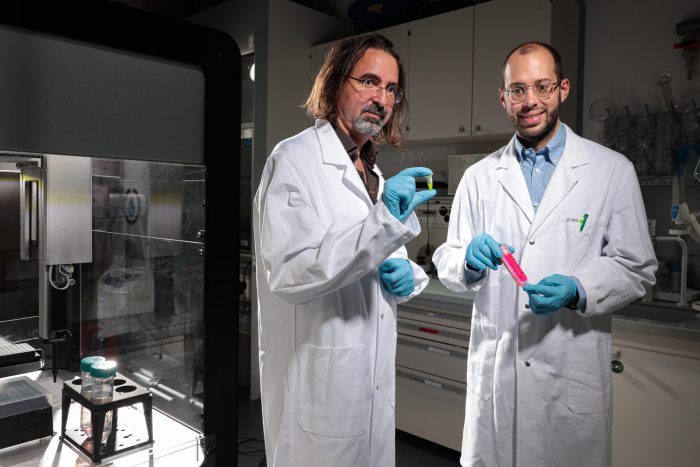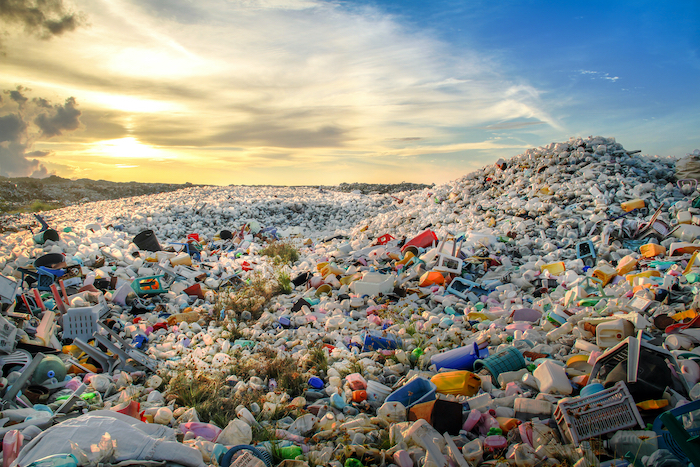Plastic pollution is an enormous problem. We use and discard a lot of it—around two metric tons per person over their lifetime. Much of that finds its way to landfill, or, even worse, into our waterways where it lives on as microplastic waste. And even recycled and compostable plastics use energy, can leave behind toxic materials, and/or need a lot of space to complete their processes.
Though we are getting a little smarter about how we use plastic—single-use plastics bans are a good sign—we've still got a long way to go. Our recycling processes are too costly and inefficient, and they aren't used widely enough.
That's why we're excited about a new nature-inspired plastic recycling study from Francesco Stellacci and Simone Giaveri, a pair of engineers at Switzerland's École Polytechnique Fédérale de Lausanne (EPFL). They claim to have discovered a way to transform plastic into entirely new materials by following how proteins behave.
What do proteins have to do with plastics? We'll get to that. Let's start with look at proteins themselves.
The magic of proteins
Yes, it looks complex, but proteins—like this sperm whale myoglobin, are made of many small parts that can be rearranged to make new things. (Getty Embed)
When you hear the word protein, you probably find yourself think about food and how you need to get a certain amount of protein to help build muscle. And with good reason.
Proteins are organic compounds called polymers that are a key part of all biological things. They are long chains of smaller molecules called amino acids. Giaveri uses a neat metaphor in their study, describing proteins like a multi-coloured string of pearls.
"A protein is like a string of pearls, where each pearl is an amino acid," he says, "Each pearl has a different colour, and the colour-sequence determines the string structure and consequently its properties." In nature, these protein chains sometimes break those pearls up, and then reorder them to form a new protein.
Though this is just metaphor and protein chains are quite complex, you can imagine it like this. A sequence of, say red-blue-green-yellow makes protein A. But if you reorder the pearls into blue-red-yellow-green, you'd get protein B!
The key here is that each individual pearl—or amino acid molecule—stays the same during this change. All that is changing is the protein made by the chain. It's like the protein is 'recycled' into something new!
Trying the same with plastics
Plastics are made of similar compounds to proteins, but they will need some help to be able to transform in the same way. (Getty Embed)
Okay, sounds neat. But what does this have to do with plastics? Well, as it turns out plastics are polymers, too, just like proteins! The only problem? They are synthetic, or artificial, polymers, and their 'pearls' are almost all the same colour!
So switching the colour order of the pearls does basically nothing to change the polymer itself. Sigh. We guess that didn't work, right? Well, not so fast, say this team of engineers.
Though they warn that it will take a 'radically different mindset', there should be a way to make plastics that built differently from the start. Ones that are built with 'multi-coloured pearls'.
In other words, plastic polymers that are engineered to be pulled apart and rearranged. Nature-inspired plastic recycling!
Circular economy

The engineers behind this idea, Francesco Stellacci and Simone Giaveri. (© Alain Herzog 2021 EPFL)
The name Stellacci and Giaveri have for this process is NaCRe, or "nature-inspired circular-economy recycling". A circular economy is a new way of designing businesses to stop waste completely. Instead of just making products that are destined to be thrown out, manufacturers find ways to design their products to be either repaired, reused, or recycled. Completely.
There's no waste.
Though it's only just a concept right now, NaCRe could create a new era of plastics that are engineered to evolve into a new material. As Stellacci says, "nature already does this."
Smart thinking!
 Plastic waste is exceptionally harmful because it is not engineered—or designed—to break down naturally. (ID 52445342 © Maldives001 | Dreamstime.com)
Plastic waste is exceptionally harmful because it is not engineered—or designed—to break down naturally. (ID 52445342 © Maldives001 | Dreamstime.com)









